Eutetramorium mocquerysi
| Eutetramorium mocquerysi | |
|---|---|

| |
| Scientific classification | |
| Kingdom: | Animalia |
| Phylum: | Arthropoda |
| Class: | Insecta |
| Order: | Hymenoptera |
| Family: | Formicidae |
| Subfamily: | Myrmicinae |
| Tribe: | Crematogastrini |
| Genus: | Eutetramorium |
| Species: | E. mocquerysi |
| Binomial name | |
| Eutetramorium mocquerysi Emery, 1899 | |
| At a Glance | • Ergatoid queen |
E. mocquerysi has queens that cannot be distinguished from workers without ovarian dissections (Heinze et al. 1999). Based on the number of ovarioles, however, two types of females can be distinguished: females (queen) with six ovarioles and a spermatheca which can mate and produce diploid offspring and females (workers) with only two ovarioles and no spermatheca but can lay unfertilized eggs.
Identification
Bolton and Fisher (2014) - This rainforest species is closely related to Eutetramorium monticellii but easily separated from it by the keyed characters. In addition, mocquerysi is larger than monticellii, has slightly longer scapes, different sculpture, distinctly larger eyes (compare measurements), and has the first gastral tergite with superficial reticular patterning everywhere on the dorsum. E. mocquerysi has queens that cannot be distinguished from workers without ovarian dissections (Heinze et al. 1999).
Keys including this Species
Distribution
Distribution based on Regional Taxon Lists
Malagasy Region: Madagascar (type locality).
Distribution based on AntMaps
Distribution based on AntWeb specimens
Check data from AntWeb
Countries Occupied
| Number of countries occupied by this species based on AntWiki Regional Taxon Lists. In general, fewer countries occupied indicates a narrower range, while more countries indicates a more widespread species. |

|
Estimated Abundance
| Relative abundance based on number of AntMaps records per species (this species within the purple bar). Fewer records (to the left) indicates a less abundant/encountered species while more records (to the right) indicates more abundant/encountered species. |

|
Biology
Colonies consist of 35±18 adults (sample of 18 colonies) nesting inside moist decaying wood lying on the forest ground.
Castes
Colonies have more ergatoid gynes than workers (Sébastien, Peeters & Fisher 2010). A single ergatoid queen was mated in each colony, and had active ovaries with "yellow bodies". Scanning electron microscopy failed to reveal differences in the thoracic structure between queens and workers. The mated, egg-laying ergatoid queen was always behaviourally dominant (high-on-legs posture, and performance of antennal boxing). The workers and virgin ergatoids behaved as nurses and foragers.
Sébastien, A., Peeters, C. & Fisher, B. 2010. Behavioural regulation of monogyny among ergatoid queens in Eutetramorium mocquerysi, an ant from Madagascar. Poster IUSSI, Copenhagen
Worker
Images from AntWeb
   
| |
| Worker. Specimen code casent0077435. Photographer April Nobile, uploaded by California Academy of Sciences. | Owned by CAS, San Francisco, CA, USA. |
 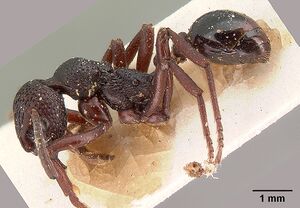  
| |
| Worker. Specimen code casent0101486. Photographer April Nobile, uploaded by California Academy of Sciences. | Owned by MNHN, Paris, France. |
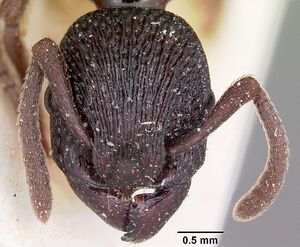  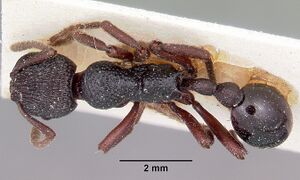 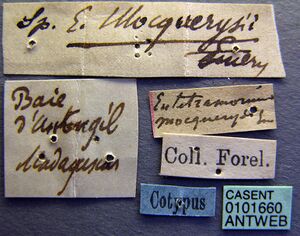
| |
| Worker. Specimen code casent0101660. Photographer April Nobile, uploaded by California Academy of Sciences. | Owned by MHNG, Geneva, Switzerland. |
   
| |
| Worker. Specimen code casent0102074. Photographer April Nobile, uploaded by California Academy of Sciences. | Owned by MSNG, Genoa, Italy. |
 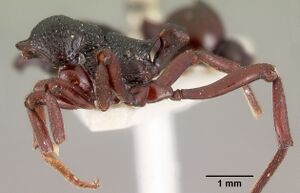   
| |
| Worker. Specimen code casent0102075. Photographer April Nobile, uploaded by California Academy of Sciences. | Owned by MSNG, Genoa, Italy. |
Male
Images from AntWeb
    
| |
| Male (alate). Specimen code casent0495192. Photographer April Nobile, uploaded by California Academy of Sciences. | Owned by CAS, San Francisco, CA, USA. |
Nomenclature
The following information is derived from Barry Bolton's Online Catalogue of the Ants of the World.
- mocquerysi. Eutetramorium mocquerysi Emery, 1899f: 281, figs. (w.) MADAGASCAR. Wheeler, G.C. & Wheeler, J. 1980: 537 (l.).
Unless otherwise noted the text for the remainder of this section is reported from the publication that includes the original description.
Description
Bolton and Fisher (2014):
Worker
TL 9.8–10.4, HL 2.08–2.18, HW 1.82–1.92, CI 86–89, SL 1.40–1.56, SI 76–83, PW 1.36–1.46, WL 2.84–3.04 (6 measured).
Palp formula 4,3. Mandible finely and densely longitudinally costulate. Cephalic dorsum longitudinally coarsely costate medially, the costae diverging posteriorly; spaces between costae with superficial ground sculpture. Sides of head with foveate pits, the spaces between which are densely shagreenate. Similar pits occur near the posterior margin of the dorsum. Eyes about at midlength of head in full-face view, EL 0.40–0.42 (EL/HW 0.21–0.22). Sides of head without projecting setae, but a few short coarse pubescence hairs may be present, appressed or nearly so. Mesotibia and metatibia each with a conspicuous simple spur. MfL 2.28–2.44 (MfL/HW 1.24–1.32). Legs covered with fine superficial reticular sculpture, superimposed upon which are scattered larger, shallow, semi-effaced punctures. Mesonotum in profile abruptly truncated posteriorly, descending almost vertically to the deeply impressed metanotal groove. Mesopleuron with a broad transverse sulcus that is unsculptured or very nearly so. Dorsal surfaces of entire mesosoma, petiole and postpetiole lack standing setae. Side of pronotum and entire dorsum of mesosoma foveate, the surfaces between foveae densely and strongly shagreenate. Propodeal spines long, slender and acute, in profile the spine 3.30–4.00 × longer than the maximum width of the propodeal lobe. Petiole in profile with a very small anteroventral process, spiracle located just anterior of the midlength of the peduncle. Postpetiole node broader than long, its width 0.70–0.74; dorsum of postpetiole shallowly foveate, the foveae less sharply defined than on the pronotum and the spaces between them punctulate-shagreenate. First gastral tergite with minute, superficial reticular patterning, and with scattered, minute, appressed pubescence, without setae. Full adult colour black, with dull brown to reddish brown legs.
Queen
Bolton and Fisher (2014) - (gyne). Extreme ergatoid (e.g. CASENT0217042). Indistinguishable from worker without ovarian dissection.
Male
Bolton and Fisher (2014) - See genus diagnosis of male for main features. Smaller than worker, HL 1.44, HW 1.36, CI 94, SL 0.42, SI 31, PW 1.36, WL 2.64, MfL 2.08 (MfL/HW 1.53), EL 0.68 (EL/HW 0.50) (1 measured). Length of first funiculus segment 0.14, of second 0.40. Maximum length of petiole 0.60, of postpetiole 1.10; maximum width of postpetiole 0.57. Dorsum of head transversely costulate behind the ocelli. Mesoscutum irregularly finely rugulose; sculpture similar but more longitudinal on mesoscutellum. Legs densely minutely punctulate on almost all surfaces, but the posterior face of the metafemur more shiny and notably less densely sculptured than the anterior face.
Type Material
Bolton 1976 - Lectotype and paralectotype workers, MADAGASCAR: Antongil, 1897-1898 (A. Mocquerys) (Museo Civico di Storia Naturale, Genoa, Genoa), here designated [examined].
References
- Bolton, B. & Fisher, B.L. 2014. The Madagascan endemic myrmicine ants related to Eutetramorium (Hymenoptera: Formicidae): taxonomy of the genera Eutetramorium Emery, Malagidris nom. n., Myrmisaraka gen. n., Royidris gen. n., and Vitsika gen. n. Zootaxa 3791, 1–99.
- Emery, C. 1899e. Formiche di Madagascar raccolte dal Sig. A. Mocquerys nei pressi della Baia di Antongil (1897-1898). Bull. Soc. Entomol. Ital. 31: 263-290 (page 281, figs. worker described)
- Fisher, B. L. 1997a. Biogeography and ecology of the ant fauna of Madagascar (Hymenoptera: Formicidae). J. Nat. Hist. 31: 269-302 (see also)
- Heinze, J. Ḧolldobler, B. and Alpert, G. 1999. Reproductive conflict and division of labor in Eutetramorium mocquerysi, a myrmicine ant without morphologically distinct female reproductives. Ethology. 105:701–717.
- Jansen, G., Savolainen, R. 2010. Molecular phylogeny of the ant tribe Myrmicini (Hymenoptera: Formicidae). Zoological Journal of the Linnean Society 160(3), 482–495 (doi:10.1111/j.1096-3642.2009.00604.x).
- Wheeler, G. C.; Wheeler, J. 1980. Supplementary studies on ant larvae: Ponerinae, Myrmicinae and Formicinae. Trans. Am. Entomol. Soc. 106: 527-545 (page 537, larva described)
References based on Global Ant Biodiversity Informatics
- Bolton B., and B. L. Fisher. 2014. The Madagascan endemic myrmicine ants related to Eutetramorium (Hymenoptera: Formicidae): taxonomy of the genera Eutetramorium Emery, Malagidris nom. n., Myrmisaraka gen. n., Royidris gen. n., and Vitsika gen. n. Zootaxa 3791(1): 1-99.
- Fisher B. L. 1997. Biogeography and ecology of the ant fauna of Madagascar (Hymenoptera: Formicidae). Journal of Natural History 31: 269-302.
- Fisher B. L. 1998. Ant diversity patterns along an elevational gradient in the Réserve Spéciale d'Anjanaharibe-Sud and on the western Masoala Peninsula, Madagascar. Fieldiana Zoology (n.s.)90: 39-67.
- Fisher B. L. 2003. Formicidae, ants. Pp. 811-819 in: Goodman, S. M.; Benstead, J. P. (eds.) 2003. The natural history of Madagascar. Chicago: University of Chicago Press, xxi + 1709 pp.
- Heinze, J., Hölldobler, B.; Alpert, G. 1999. Reproductive Conflict and Division of Labor in Eutetramorium mocquerysi, a Myrmicine Ant Without Morphologically Distinct Female Reproductives. Ethology 105 (8): 701-717



